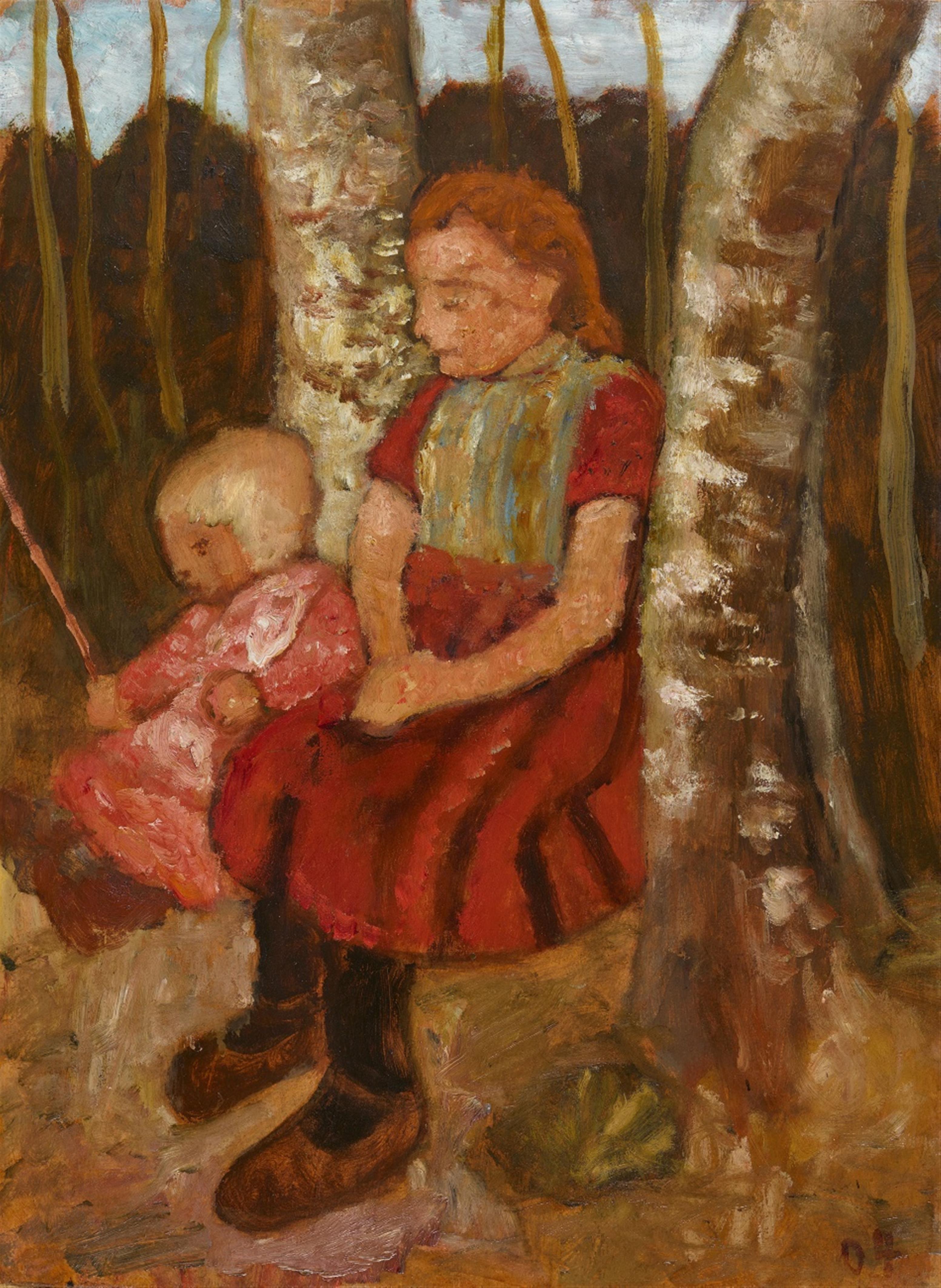Paula Modersohn-Becker
Kinder zwischen Birkenstämmen
1904
Oil on card, laid down on wooden panel 69.5 x 51 cm Framed. Dated '04' in red lower right. - The card margins irregularly cut. - Minor craquelure in the outermost upper margin.
It was Paula Modersohn-Becker's mother in Bremen who owned the present painting, which Gustav Pauli still listed under the title “Kinder unter Birken”. In the layout of the composition, in the selected colours and in the simplifications of its visual indications, it provides an exemplary summation of the elements of her developing personal style. Far removed from any sort of sentimentality and detached observation, Paula Modersohn-Becker succeeds in radiating human intimacy and depth of feeling in this likeness. The motif of children, which was to become so fundamental, still incorporates situational as well as naturalistic, landscape elements. This would become almost entirely lost in the portraits after 1906, which brought further stylistic and formal developments favouring, among other things, full-face depictions with flowers and blooms as attributes.
From the very beginning, the artist fought to achieve an independent, distinctive mode of expression in her painting, which was to be the new and authentic result of her work. In Worpswede, Paula Modersohn-Becker was met by a rustic type of people shaped by the landscape and their living conditions, and they literally became her “model”: a catalyst and touchstone for her extremely individual experiments in form and colour. It was certainly not what her mother had still, somewhat helplessly, admonished her to do in the beginning: “Now nail yourself down, too, compel yourself to pedantic precision in hands, eyes, noses. Mackensen recently spoke about an 'unloved ear' while looking at one of your studies. He did not say it humorously, but seriously as a judge of the dead” (cited in: Cornelia Saxe, in: Britta Jürgs (Ed.), Wie eine Nilbraut, die man in die Wellen wirft, Berlin 1998, p. 17). According to her daughter, however, the “genre” (of someone like Fritz Mackensen) should be countered through something like an artistic “runic alphabet” (see S. D. Gallwitz (Ed.), Briefe und Tagebücher von Paula Modersohn-Becker, Munich 1927, p. XI).
It is well known that Paula Modersohn-Becker found complementary and many-faceted artistic inspiration in Paris purely through looking at works. On 25 February 1903 she noted: “I see a great deal and I believe I am inwardly moving closer to beauty. In the last few days I have found and thought a lot of form. [...] The grand simplicity of form - that is something marvellous. As far back as I can remember, I have always tried to invest the heads I painted or drew with the simplicity of nature. Now I feel deeply how I can learn from the heads of antiquity. How grandly and simply they are seen! Brow, eyes, mouth, nose, cheeks, chin, that is everything. It sounds so simple and is nonetheless so very, very much. How simply such an antique mouth is grasped in its planes. Then I feel how, when drawing, I must seek out many peculiar forms and overlappings in nature. This feeling of the merging and superimposing of things suits me. I only have to attentively cultivate and refine it. I want to draw much more in Worpswede. I want to pose groups for myself of the children from the almshouse or the A. family or N. family. I am very much looking forward to the work; I believe my stay here will have done me a great deal of good.” (cited in: Gallwitz, op. cit., Munich 1927, pp. 198/199).
Catalogue Raisonné
Busch/Werner 498; Pauli 152 a ("Kinder unter Birken")
Provenance
Frau Baurat Becker, Bremen (1913); Sammlung Max Lütze, Berlin/Hamburg (1931); Erna Lütze, Stuttgart (1972 on private loan to the Staatsgalerie Stuttgart, Inv. Nr. L 1095); Private collection, Hesse
Exhibitions
Stuttgart 1972 (Staatsgalerie Stuttgart), Sammlung Lütze, Deutsche Kunst des XX. Jahrhunderts, catalogue p. 21 (erroneously described as on canvas); until 1975 deposit of the Staatsgalerie Stuttgart (museum label with inventory number verso)

